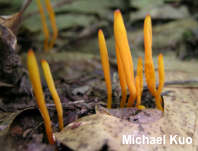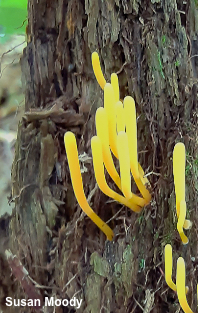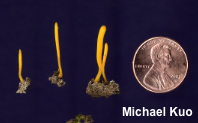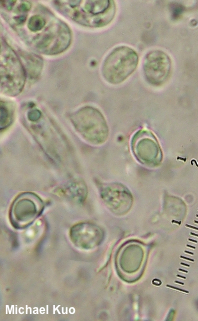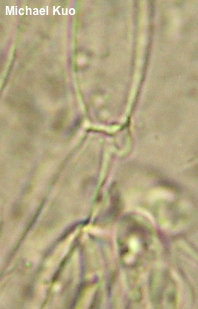| Major Groups > Clubs & Corals > Clavulinopsis laeticolor |

|
Clavulinopsis laeticolor [ Basidiomycota > Agaricales > Clavariaceae > Clavulinopsis . . . ] by Michael Kuo This tiny club fungus is easily overlooked, and can be quite a challenge to collect, unless you happen to carry tweezers with you when you go collecting. And, to be honest, if you do carry tweezers on your woodland mushroom outings, you probably need help. At any rate, Clavulinopsis laeticolor is, as a translation of its Latin name suggests, joyfully colored; it is typically orange or bright orangish yellow. It is distinguished from similar tiny, yellowish club mushrooms by its dry surface, its tiny size (often only a few centimeters in height), and its tendency to grow alone or gregariously, rather than in tightly packed clusters. Under the microscope, Clavulinopsis laeticolor has distinctive, oddly-shaped spores. Clavulinopsis fusiformis is similar but larger; it grows in clusters and has differently shaped spores. Clavaria laeticolor, Clavaria pulchra, Clavulinopsis pulchra, and Ramariopsis laeticolor are synonyms. Thanks to Sue Moody for documenting, collecting, and preserving Clavulinopsis laeticolor for study; her collection is deposited in The Herbarium of Michael Kuo. Description: Ecology: Presumably saprobic; growing alone, scattered, gregariously, or in loose groups under hardwoods or conifers; usually terrestrial but occasionally appearing on well-rotted, moss-covered stumps; summer and fall (also winter in warmer climates); originally described from Cuba; widely distributed in North America; also documented from Central America, South America, Europe, Asia, and Oceania. The illustrated and described collections are from Illinois and Minnesota. Fruiting Body: 17–50 mm high; 1–4 mm wide; cylindrical and unbranched; sometimes somewhat flattened, or with a groove or a twist; dry; bald; bright orange or yellow; fading with age; whitish at the extreme base; at maturity often with a somewhat pointed tip that ages or discolors somewhat reddish or orange. Flesh: Whitish to pale yellow or orange; thin. Odor and Taste: Not distinctive. Chemical Reactions: Iron salts negative to grayish on surfaces; KOH orangish. Microscopic Features: Spores 5–7 x 3.5–5 µ; irregularly subellipsoid to subamygdaliform, with a large protruding apiculus; smooth; hyaline and often uniguttulate in KOH; inamyloid. Basidia 35–55 x 5–8 µm; subclavate; 4-sterigmate. Cystidia not found. Contextual hyphae 3–5 µm wide; smooth; thin-walled; hyaline to golden in KOH; with small clamp connections. REFERENCES: (Berkeley & Curtis, 1869) R. H. Petersen, 1965. (Coker, 1923; Corner, 1950; Petersen, 1965; Petersen, 1968; Petersen, 1978; Smith, Smith & Weber, 1981; Arora, 1986; Breitenbach & Kränzlin, 1986; Barron, 1999; McNeil, 2006; López & García, 2008; Trudell & Ammirati, 2009; Buczacki et al., 2012; Birkebak et al., 2013; Desjardin, Wood 7 Stevens, 2015; Messuti & Lorenzo, 2015; Furtado et al., 2016; Siegel & Schwarz, 2016; Baroni, 2017; Elliott & Stephenson, 2018; Læssøe & Petersen, 2019.) Herb. Kuo 06200301, 07200705, 09221201, 08202001. This site contains no information about the edibility or toxicity of mushrooms. |
© MushroomExpert.Com |
|
Cite this page as: Kuo, M. (2020, October). Clavulinopsis laeticolor. Retrieved from the MushroomExpert.Com Web site: http://www.mushroomexpert.com/clavulinopsis_laeticolor.html |
